|
Classics Illustrated was one of the most successful American comic book publishing ventures in history.
From the early 1940's, when the series began as "Classic Comics", until the late 1960's, the series published comic book adaptations of fine literature. Unlike most comic books of the time, which were intended to be sold on newsstands
for a limited time, the Classics Illustrated comics were frequently kept in print. When an issue sold out, the publisher simply went back to press
with a new printing. Most back issues were kept in stock and could be ordered directly from the publisher.
The series did not escape the notice of Dr. Fredric Wertham. He criticized numerous issues of Classics Illustrated, as indicated below.
While most issues were kept in print for many years, some issues such as #43 and #44 were discontinued. Were these titles discontinued because of criticism from Dr. Wertham?
That does seem to be a likely scenario, but we are unaware that there is any direct evidence to support this theory. If you have any information regarding why issues
#43 and 44 were discontinued, we'd love to hear about it.
| Classic Comics #10 | Robinson Crusoe | Mentioned in SOTI, p. 142.
Typical is the case of the eleven-year-old boy of superior intelligence, from a good social and economic background, who exhibited the "classics" comic-book version of Robinson Crusoe with these words: "Why should I read the real book if I have this? If I had to make a report I could use this. It would leave out all the boring details that would be in a book." | 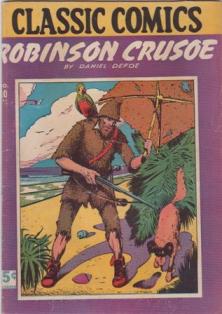 |
| Classic Comics #13 | Dr Jekyll & Mr. Hyde | Mentioned in SOTI, p. 143.
A fourteen-year-old boy in the eighth year at school, with a second-grade reading level, says that he has read the "classics" version of Dr. Jekyll and Mr. Hyde: "It is called The Mad Doctor. He makes medicine. He drinks it and turns into a beast. He kills a little girl. The cops chase him. Then he changes into a man. He comes to a famous home and falls in love with a girl. He keeps changing. Finally he gets shot. While dying he changes back to a human being. I like when he comes to the little girl and hits her with a cane." |  |
| Classic Comics #15 | Uncle Tom's Cabin | Mentioned in SOTI, pp. 102, 103.
Even the comic book version of Uncle Tom's Cabin has been characterized by a pupil in a school magazine like this: The Classics Comics version of Uncle Tom's Cabin gives the impression that the Negro is still that stereotyped man who sings about "going to glory" all day. Mrs. Stowe's book shows the Negro to be a human being. | 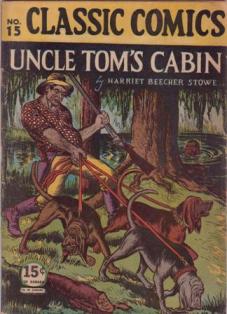 |
| Classics Illustrated #43 | Great Expectations | Mentioned in SOTI, p. 311.
There is a comic book which has on its cover two struggling men, one manacled with chains locked around hands and feet, the other with upraised fist and a reddened, bloody bandage around his head; onlookers: a man with a heavy iron mallet on one side and a man with a rifle and a bayonet on the other. The first eight pictures of this comic book show an evil-looking man with a big knife held like a dagger threatening a child who says: "Oh, don't cut my throat, sir!" Am I correct in classifying this as a crime comic? Or should I accept it as what it pretends to be - Dickens' Great Expectations? | 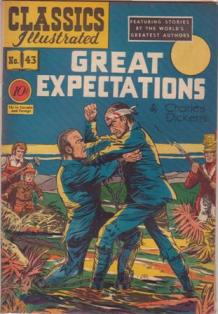 |
| Classics Illustrated #44 | Mysteries of Paris | Wertham criticized this comic in his 1948 article in the Saturday Review of Literature.
In one of the 'good' comic books, ('Classics Illustrated') in a rendering of the novel by Eugene Sue, The Mysteries of Paris, there is a picture of a man tied down to a chair-- a man whose eyes have been gouged out and whose blood runs down from beneath the bandage. Wertham also mentioned this comic is the text of SOTI, p. 323.
I had written that in the "good" comic book The Mysteries of Paris blood shows beneath the bandage of a man whose eyes have been gouged out. The publisher demanded a retraction. But I stood my ground, because the blood was there. |  |
| The Mysteries of Paris Mystery
Dr. Wertham's writings about Classics Illustrated #44 are curious when compared to the images in that comic book of the character whose eyes have been gouged out. Below you'll find images from
four of the five known printings of Classics Illustrated #44. While the forehead above the bandage looks somewhat bloody in the original printing, none of the images below
seems to match precisely what Wertham was describing. There is no blood below or underneath the bandage. The only edition we have not located and photographed for the SeductionOfTheInnocent.org website is the edition printed on
stiff paper. If you have that edition and you'd be willing to provide a scan or photo, please contact us.

Panel from original printing. Note that red above the bandage could be construed as blood above, not below, the bandage. | 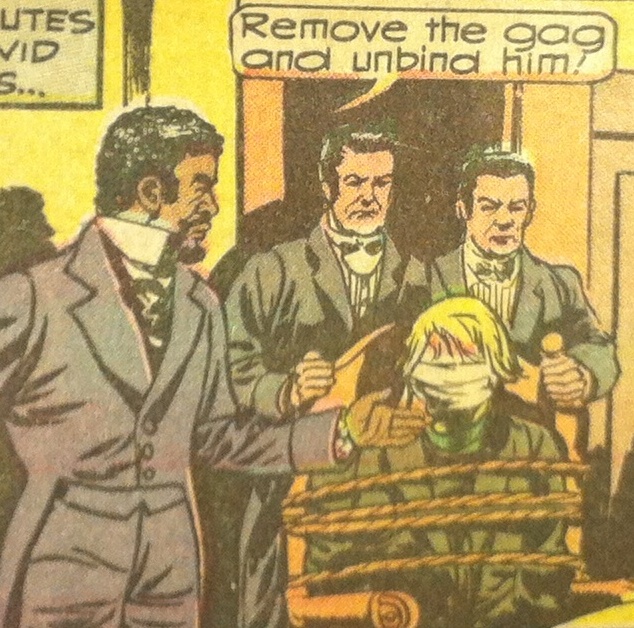
Panel from 1949 reprint (HRN62) with gift box ad on bc.
| 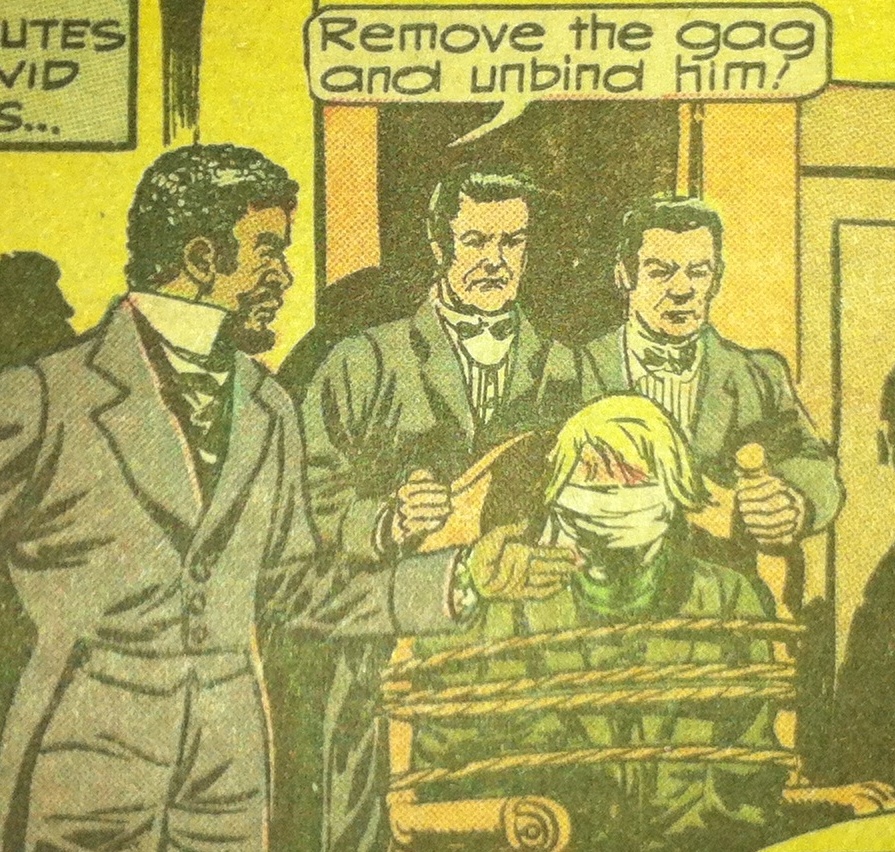
Panel from 1949 reprint (HRN 62) with reorder back cover. | 
Panel from 1950 reprint (HRN78).
|
|
| Classics Illustrated #50 | The Adventures of Tom Sawyer | Mentioned in SOTI, p. 37.
An adaptation from one of Mark Twain's novels has the picture of two small boys in a fight, one tearing the other's hair - a scene not the keynote of Mark Twain's novel. Inside, three consecutive pictures show a fight between two boys ("In an instant both boys were gripped together like cats")' and the last picture shows one boy with a finger almost in the other's eye (the injury-to-the-eye motif again). | 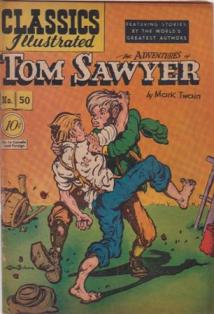 |
| Classics Illustrated #55 | Silas Marner | Mentioned in SOTI, pp. 311, 312.
In the case of George Eliot's Silas Marner the children laughed "at the droll discrepancies in the story and the incongruities in the illustrations": "Silas is represented as senile and hoary, somewhat like the Ancient Mariner throughout"; "the flavor of George Eliot, the warm human touches, the scenes of matchless humor, had been completely ignored by the Classic Comics." | 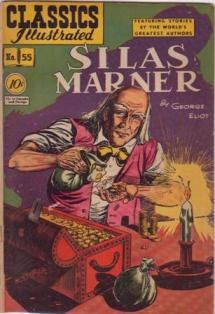 |
| Classics Illustrated #68 | Julius Caesar | Mentioned in SOTI, p. 36,37.
David Dempsey, writing in the New York Times Book Review, has said of the comic book Julius Caesar that it has "a Brutus that looks astonishingly like Superman. 'Our course will seem too bloody to cut the head off and then hack the limbs...' says Brutus, in language that sounds like Captain Marvel..." and he notes that "Julius Caesar is followed by a story called 'Tippy, the Terrier.'" |  |
eBayer Hoppywho contributed information for this page. If you have anything to contribute, please just contact us.
|